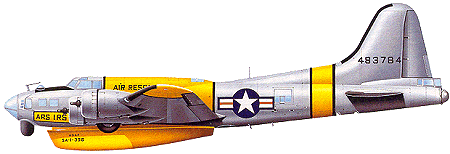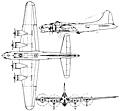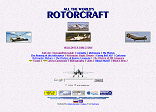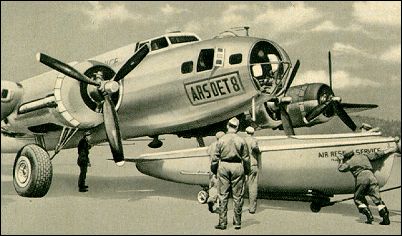|
| Frustrated in their efforts to acquire a fleet of strategic bombers for service with the Army Air Corps, US Army planners - who were devotees of the theories expounded by Brig Gen William 'Billy' Mitchell - inserted the thin end of an important wedge when they ordered a small number of YB-17 prototypes in January 1936, ostensibly for the nation's defence. Originating as the Boeing Model 299, the prototype was built as a private venture, Boeing gambling heavily on producing a winner that would bring a large military contract. It must have seemed to Boeing that their gamble had failed when, almost at the end of the military trials, the Model 299 crashed on take-off. Fortunately investigation proved that the aircraft had been flown off with the flying controls locked and safety of the basic design was not suspect.
It was not until 1938 that the USAAC was able to place an order for 39 production B-17B, the last of this batch entering service in March 1940. These were the first B-17 production aircraft to be equipped with turbocharged engines, providing a higher maximum speed and much increased service ceiling. Of the B-17C which followed, a batch of 20 were supplied to the RAF (designated Fortress I) and used operationally in Europe for evaluation, leading to improved B-17D and B-17E aircraft with self-sealing fuel tanks and revised armour and armament.
The B-17E was truly a flying fortress, armed with one 7.62mm and 12 12.7mm machine-guns for defence and able to carry a maximum 7,983kg of bombs. Most extensively built variant was the B-17G (8,680), being built by Douglas and Lockheed Vega as well as at the Boeing plant, Seattle. Pratt & Whitney R-1820-97 radial engines and improved turbochargers enabled the B-17G to operate at an altitude of up to 10,670m; and the addition of a chin turret below the nose (containing two 12.7mm machine-guns) provided better defence against the head-on attacks being launched by Luftwaffe fighter pilots in their attempts to reduce the numbers of Fortresses striking daily at strategic targets deep in German territory.
Special variants included the B-40 with up to 30 machine-guns/cannons, which was intended as a B-17 escort, but proved to be an operational failure; BQ-7 pilotless aircraft packed with explosives to be deployed against German targets by radio control, which failed due to unreliable control equipment; CB-17 and C-108 transports; and F-9 long-range B-17 equipped to serve as an air-sea rescue aircraft and able to deploy a lifeboat carried beneath the fuselage.
In Britain, more than anywhere else in the world, the B-17 evokes vivid memories of courageous aircrew who day after day - despite sometimes horrific losses - continued to attack targets in Europe until victory was won. For Boeing, their private-venture gamble paid off: a total of 12,731 Fortresses were built by the Boeing, Douglas and Lockheed team.

| CREW | 11 |
| ENGINE | 4 x Wright-Cycl. GR-1820-97, 885kW |
| WEIGHTS |
| Take-off weight | 32720 kg | 72136 lb |
| Empty weight | 24900 kg | 54895 lb |
| DIMENSIONS |
| Wingspan | 31.6 m | 104 ft 8 in |
| Length | 22.7 m | 75 ft 6 in |
| Height | 5.8 m | 19 ft 0 in |
| Wing area | 141.9 m2 | 1527.40 sq ft |
| PERFORMANCE |
| Max. speed | 438 km/h | 272 mph |
| Cruise speed | 250 km/h | 155 mph |
| Ceiling | 10700 m | 35100 ft |
| Range | 2980 km | 1852 miles |
| ARMAMENT | 13 x 12.7mm machine-guns, 8000kg of bombs |
 | A three-view drawing (1000 x 927) |
| Joe Hodder, e-mail, 03.08.2008 20:33 I don't knw how the air-sea rescue version was designated but the F-9 was a Photo variant of the G Model. It had a tri-cam array in place of the chin turret, the standard vertical camera station in the radio room and a sling to aid the photographer taking long focal length pictures out the waisst windows. The aircraft didn't hae any guns, armor plate, or bomb racks. Some had "Tokyo Tanks" in the bomb bay which gave them a 14 1 /2 hour range with a 45 min. reserve. One such aircraft was assigned postwar at Neubiburg to eveluate several items of German aerial photo equipment. reply | | stephen russell, e-mail, 15.06.2008 03:44 Love the B40 gunship mode & the B38 superfast models.
2 bad B40 didnt work out in the skies.
Seen No models etc on B-40 or B-38 variants. reply | | stephen russell, e-mail, 15.06.2008 03:44 Love the B40 gunship mode & the B38 superfast models.
2 bad B40 didnt work out in the skies.
Seen No models etc on B-40 or B-38 variants. reply | | Chuck Neilson, e-mail, 01.06.2008 07:51 I flew 35 missions out of Foggia,Italy as a tail gunner during 1944-45 and never saw a more airworthy plane. We came back over the Adriatic, fearing ditching in the water, but made it in on one engine full power, one half power & two dead engines. My hat was off to that plane. reply | |
| | 'Ol Glenn, e-mail, 21.04.2008 14:30 I grew up in a small town in Nebraska near an airbase where air crewa learned formation flying to maximize the effectiveness of their firepower against German fighters. What a majestic plane the B-17 was. reply | | EM Carlaw, e-mail, 13.09.2007 02:27 Hello, I have a question concerning the data plates on the -97 series of engines during WW2. I have heard that early in the war the acceptance dates were cut from the data plates to keep the Germans from finding vital information. Could someone update me on this info? Thanks reply | | GIULIANO, e-mail, 09.07.2007 12:46 CIAO I AM LOOCKING FOR THE MANUAL OF CREW OR ROFI(RADIO OPERATOR FILE IN.
CAN YOU HELP ME?
THANK YOU
BEST REGARDS reply | | Joseph H. Peek, e-mail, 30.04.2007 07:09 I was a small boy in 1941, only 6&1 /2 years old when my father died of kidney trouble and I moved from Hayden, AZ to Tucson, AZ with my mother. We lived about three miles from Davis Monthan Air Force Base and watched the B-17 Fortresses fly almost continuously. They were awesome and gave me a thrill each time they came over the house. I finally got to climb into one at Peachtree-DeKalb airport here in DeKalb County about a year ago. I was surprised at the cramped conditions in which those aviators had to work. I am six feet and 240 and would never have made it into the cockpit. I flew S2F Trackers in the Navy and had the same Wright 1830-82A engines with sealed harness for sea duty. What a great engine to fly. Call me 404-325-4866 Cell in GA. reply | | Bob T, e-mail, 08.07.2008 20:43 I was a tailgunner in Glatton, England during the War and can't remember for sure what the takeoff speeed was with a loaded airplane; can anyone help? reply |
|
Do you have any comments?
|
| 
COMPANY
PROFILE
All the World's Rotorcraft
|








